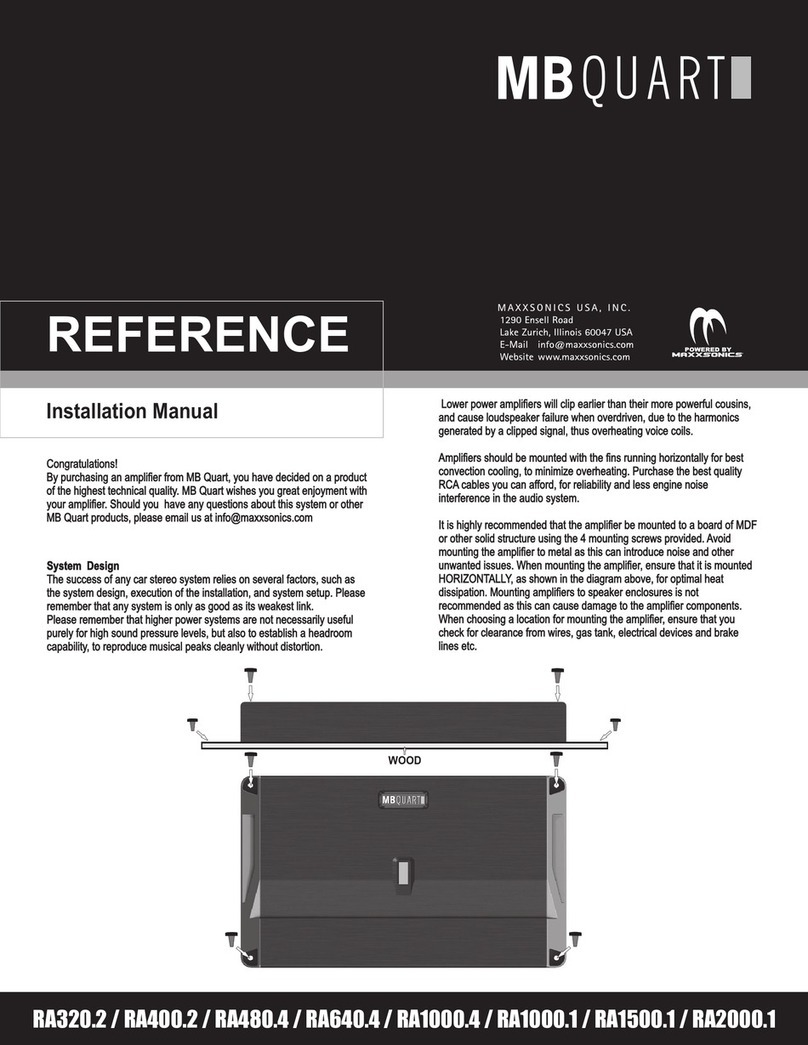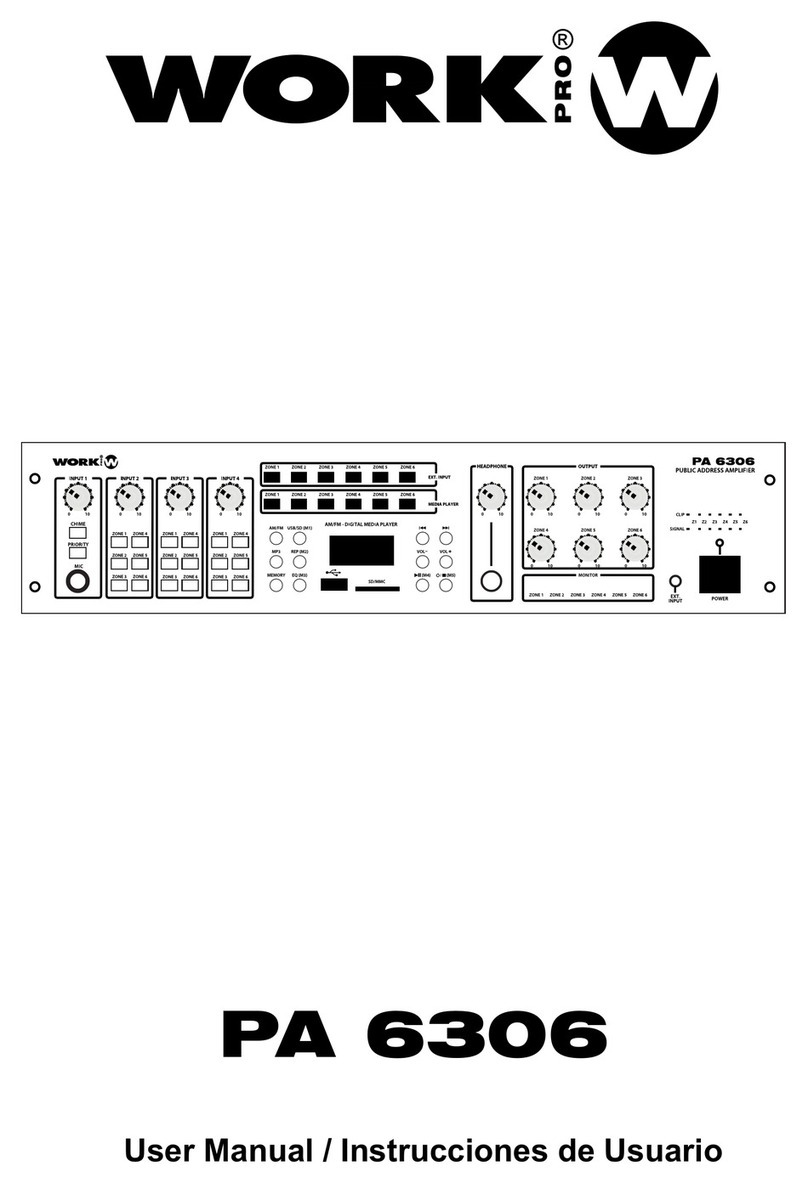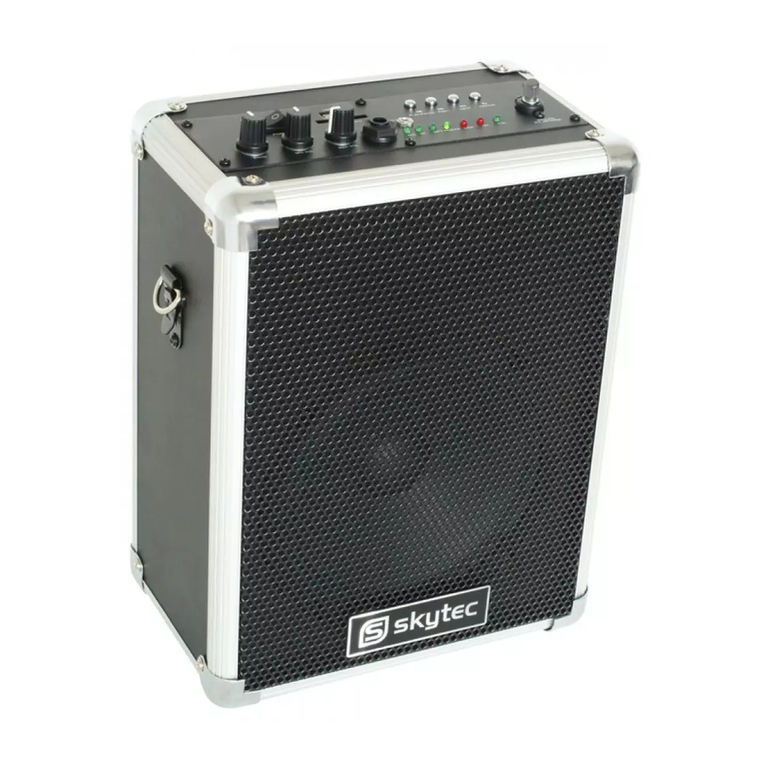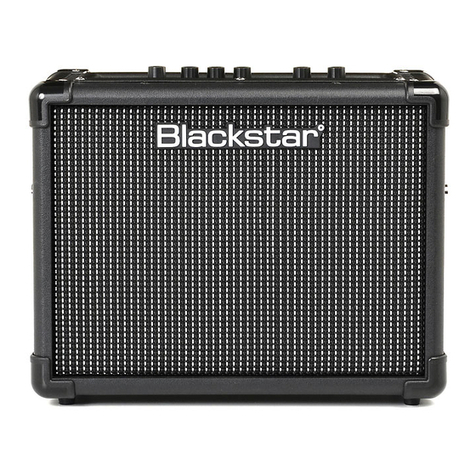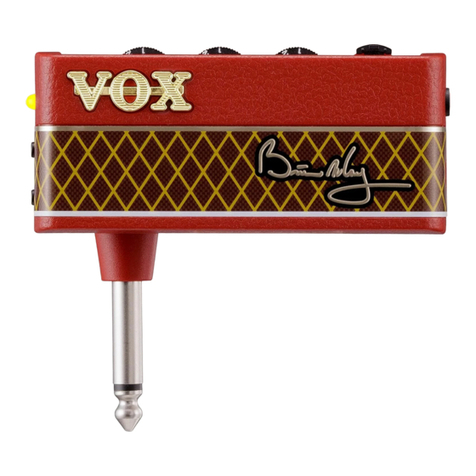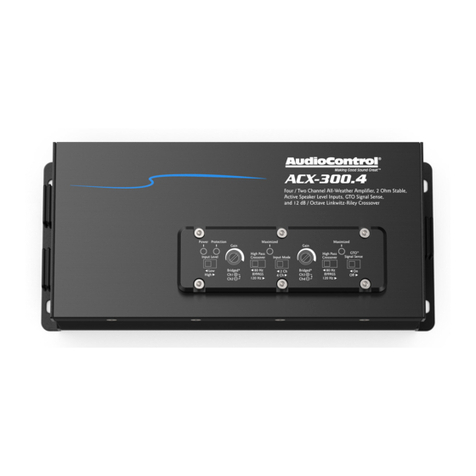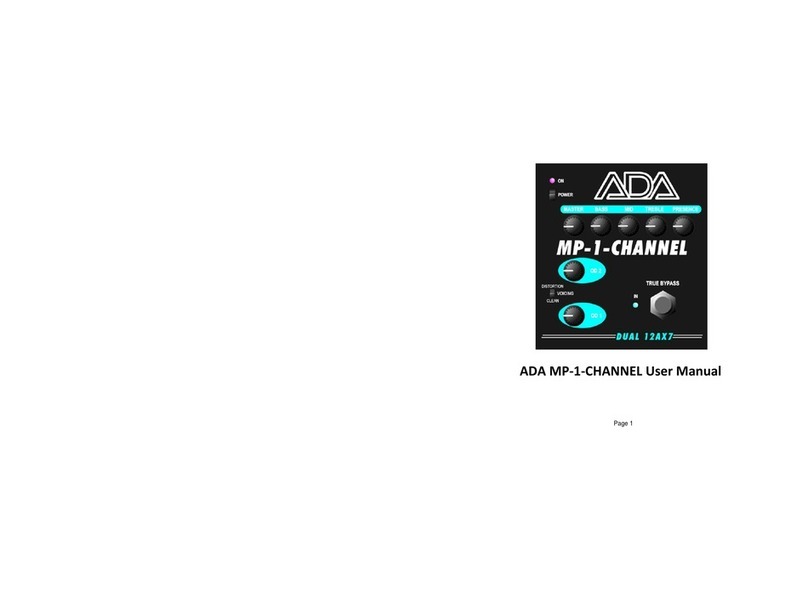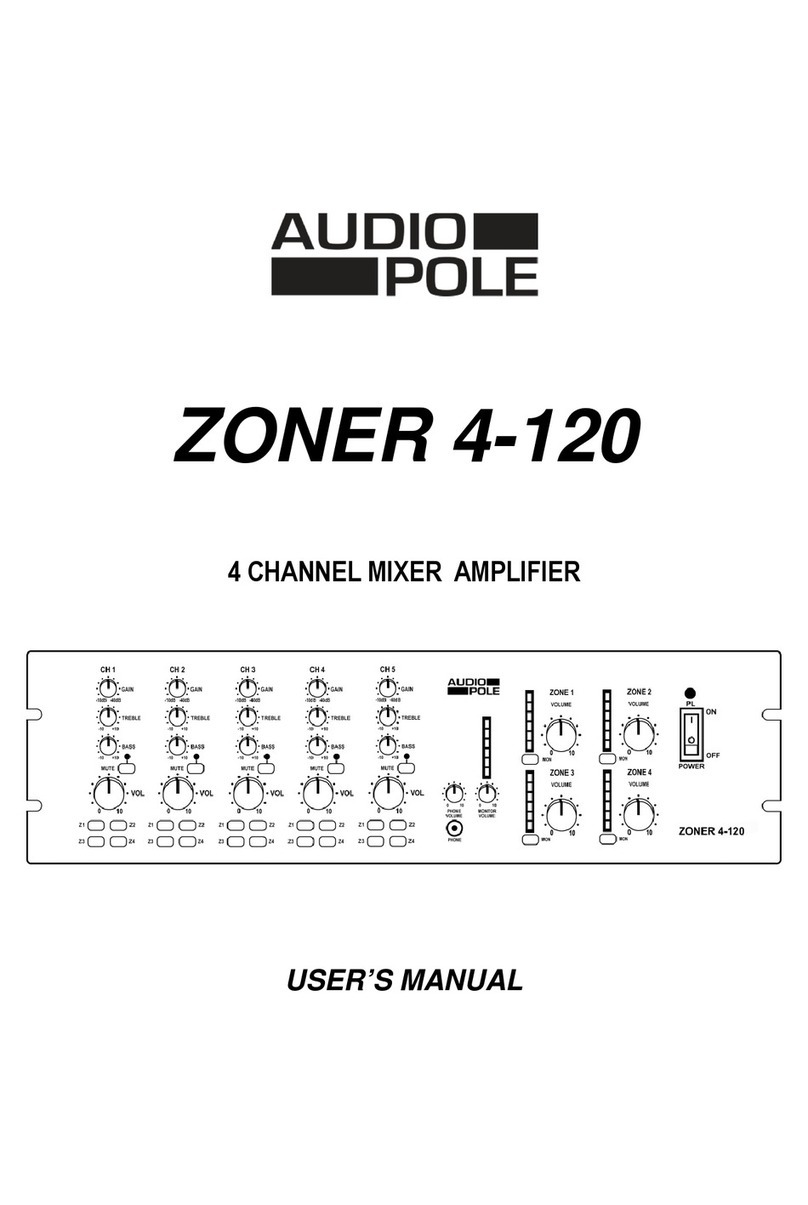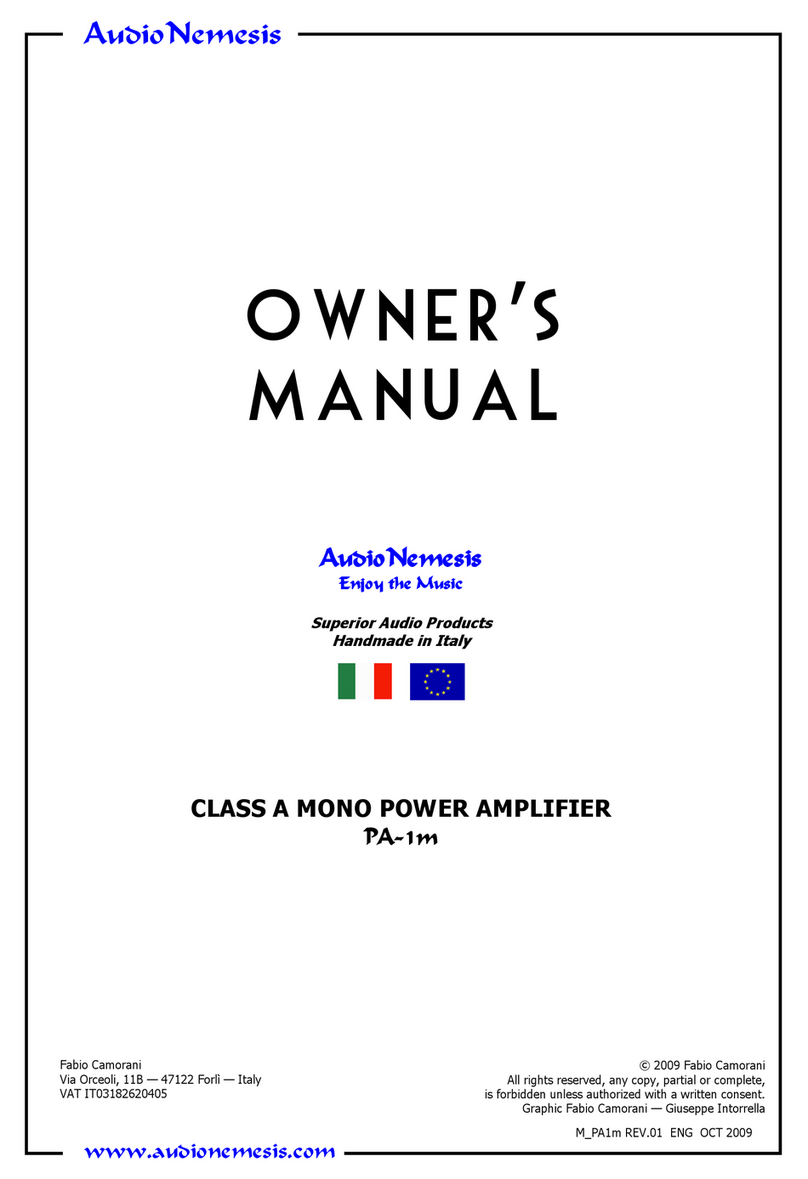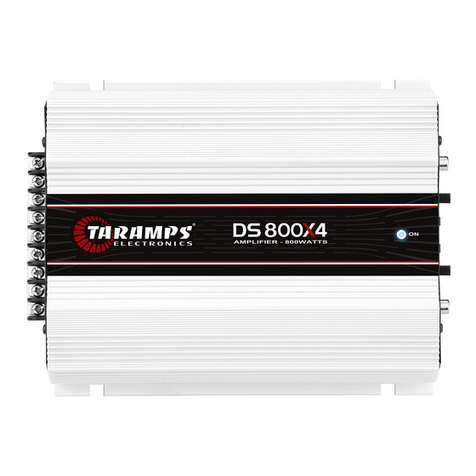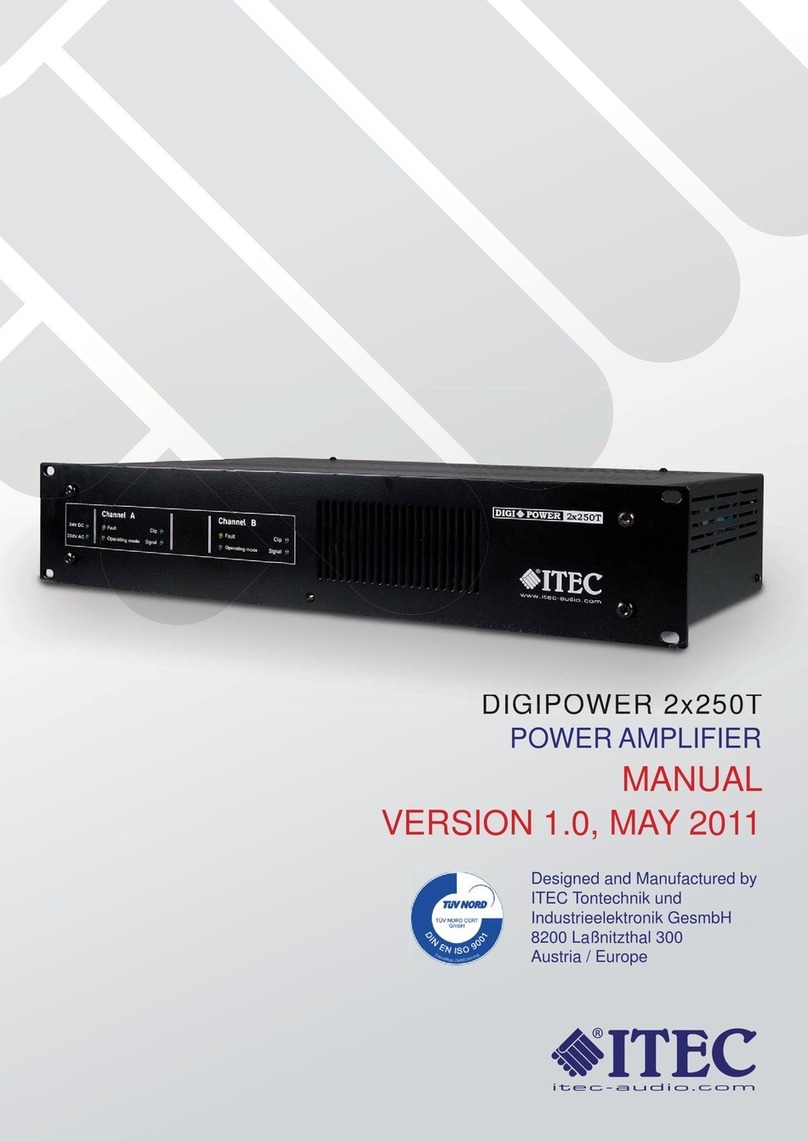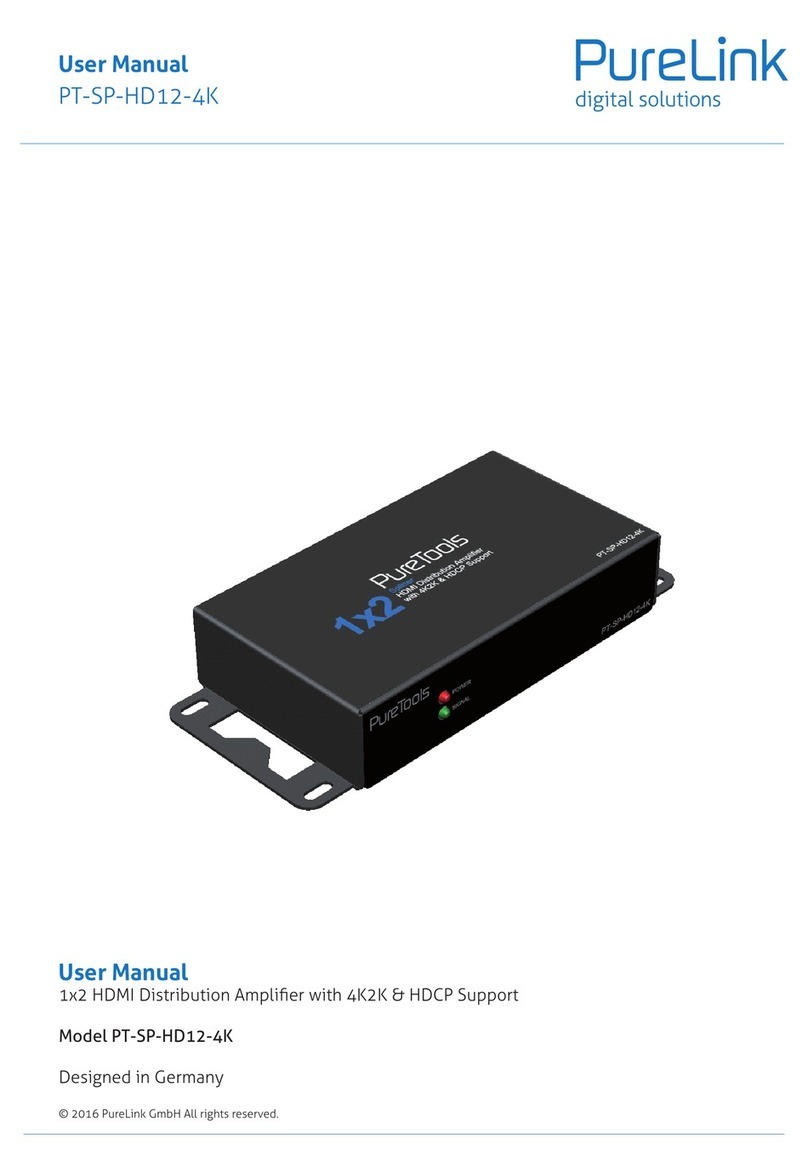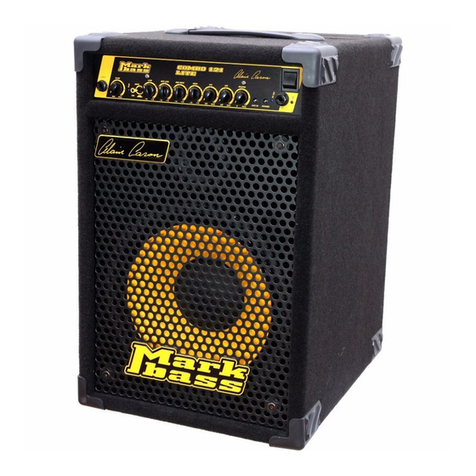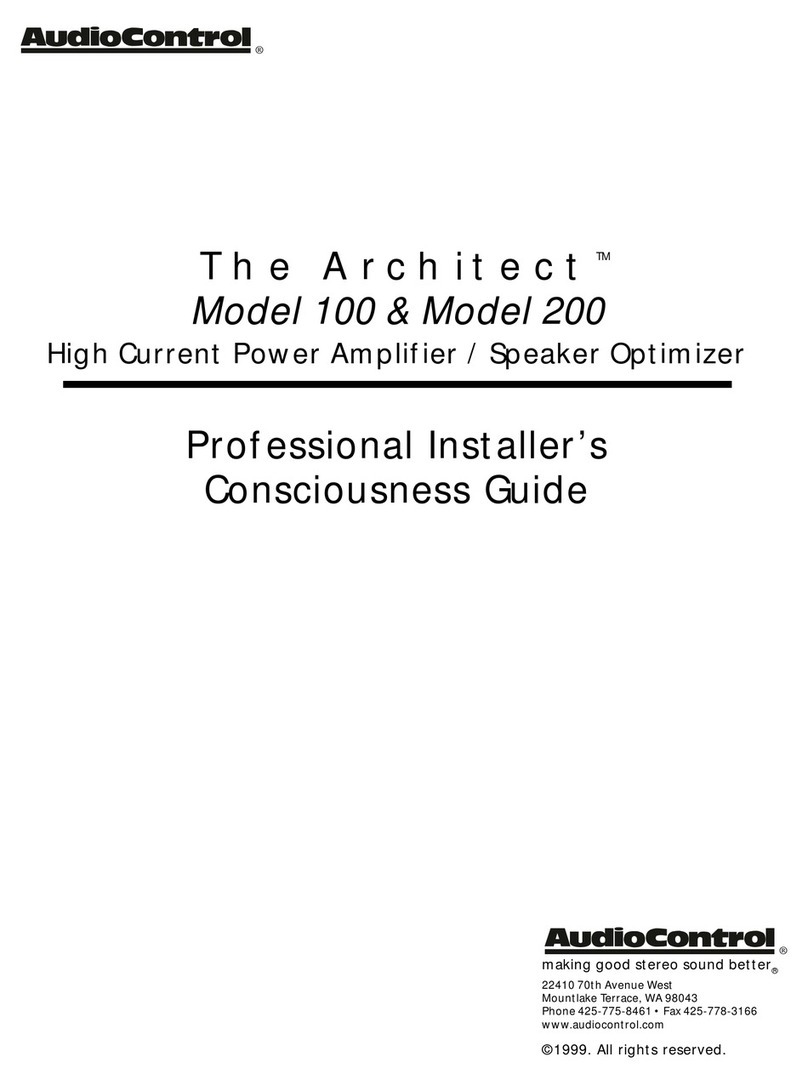Chapter Preface Plus Line Stage User manual

C H A P T E R P R E F A C E P L U S
Chapter
Preface Plus Line Stage
Pre amplifier
The exception, not the rule...
www.chapterelectronics.co.uk

Table of Contents
2
Important Safety Instructions................................... 3
Thank You from Chapter.......................................... 4
Introduction.............................................................. 5
Unpacking your Pre-Amplifier................................... 6
Break In Period........................................................ 6
Installation................................................................ 7
Ventilation................................................................ 7
Operating Voltage and Mains Conditions................ 8
Design Features...................................................... 9
Front Panel............................................................... 10,11,12&13
Rear Panel................................................................ 14
Remote Control......................................................... 15
Specifications............................................................ 16
Conformity & Acknowledgements............................. 17
Warranty Information................................................ 18
Contact Information.................................................. 19

Important Safety Instructions
Please read all instructions and precautions carefully before operating your
Chapter Preface Pre-Amplifier.
1 Please disconnect all items in your audio or AV system before connecting or
disconnecting any mains or interconnect cables, or when cleaning
your Chapter product.
2 Please ensure that your Chapter product is always terminated with a
three pin AC power cord. To prevent the possibility of shock all three
connections must be used.
3 To clean your Chapter product please use a soft damp cloth. Never use
flammable or combustible chemicals.
4 Never operate this product with any covers removed.
5 Never allow the inside of this unit to become wet, or pour / spill liquids
directly onto it .
6 Never block air flow through the vents on the side panel.
7 Never bypass any fuse.
8 Never replace a fuse with anything other than those specified.
9 There are no user serviceable parts within this product. If problems occur,
please contact your Chapter retailer.
10 Never expose this product to extremely high or low temperatures.
11 Unplug this product during lightning storms.
3

From all of us at Chapter...
Preface Mk 2
From dream to reality...
Thank you for choosing the Chapter Preface
Pre-Amplifier.
It has been designed and manufactured to the
highest possible standards in order
to give you many years of musical enjoyment.
4

The Chapter Preface Pre-Amplifier is a new ‘state of the art’ audiophile two-channel
line stage pre-amplifier, that has evolved from the acclaimed Preface and laterly
Preface Plus pre amplifier launched in 2003 and 2006 respectively.
The Pre-amp features a number of new design features along with scrupulous
attention to technical detail.
Our objective is to provide a product capable of great musicality and realism whilst
boasting exemplary technical specifications. By bringing together engineers and
designers with a lifetimes experience in audio and power system design we believe
this objective has been more than achieved.
The Chapter Preface is able to handle all of today’s high-resolution sources, with the
fidelity that you would expect of any Chapter product.
Our goal, as always, is to produce a true reference quality line stage. A product that
can be held in the highest regard from both objective and subjective perspectives.
After several years of research and development, we believe that we have
succeeded in fulfilling the requirements of even the most discerning audiophile.
Introduction
5

Unpacking your Pre-Amplifier
The shipping weight of your Chapter Preface Pre-Amplifier is 20 KG.
Therefore, under normal circumstances, one person should be able to unpack the
unit safely. If you are in any doubt, please obtain the assistance of a second person.
To avoid back injury whilst carrying your amplifier (or any other piece of heavy
equipment) please crouch with a straight back and use your leg muscles.
After unpacking your pre-amplifier, please retain all packaging for future transport. If
you move house or you need to ship your pre-amplifier, only the custom designed
packaging is acceptable. Any other method of shipping may result in damage and
such damage is not covered under warranty.
Please inspect your pre-amplifier for possible damage due to shipping. If you
discover any, contact your Chapter Audio dealer immediately.
Your Chapter Preface Pre-Amplifier will deliver excellent performance straight out
of the box, however, you should expect to hear it improve as it reaches its normal
operating temperatures and its various components ‘break-in’. In our experience the
most significant changes occur within the first 30 - 50 hours use, but the unit will
continue to improve in sound quality for about 100 hours, after which time it remains
quite consistent.
If the power is removed and reconnected to the pre-amplifier, you must allow a brief
‘warm up’ period for the unit to give off its best.
However, it is not recommended to leave your Chapter Preface Pre-Amplifier on
permanently.
Break In Period
6

Installation
Ventilation
Your Chapter Preface Pre-amplifier has been designed to fit into a good quality
equipment rack or amplifier stand. In most installations locating the pre amp near
the source components is best. By doing this you minimise the length of any
unbalanced interconnect cable that you may be using.
Where permitting, locate the power amplifier near the loudspeakers and use a
longer pair of balanced interconnects to your Preface unit.
The advantage to this strategy lies in the fact that the interconnects carry low
current signals that are easily transmitted over distances with greater accuracy
than the high current signals required by loudspeakers.
Your Preface Pre-Amplifier has been designed to drive the most demanding of cable
runs and amplifier loads with ease.
The back of your Preface Pre amplifier has been laid out to keep every
connection accessible. We recommend that you leave some clearance behind the
unit to fit cables without having to bend them excessively.
In order to conform with CE regulations your pre-amp is fitted with a rocker
style power switch on the rear of the unit as well as a ‘standby’ switch on the front
plate. This rear mounted rocker switch disconnects power from the power supply,
resulting in effective disconnection of the amplifier from the AC mains.
Please allow your pre-amplifier to have at least five centimetres between the top
cover and the next shelf up on an equipment rack.
The slotted vents on the side of the pre-amp must not be obstructed, as this would
reduce the free flow of air through the unit.
7

Operating Voltage and Mains Conditions
A good quality three pin, 5 ampere IEC standard, detachable mains lead is
provided for use with your pre-amplifier. It is recommended that you use this lead.
Please contact us for advice if replacement is required.
The Chapter Preface uses several very low noise, double regulated, linear power
supplies to control digital, analogue and control circuitry. Using large custom made
screened transformer and a fastidious attention to circuit layout gives the unit
staggering noise performance, whilst an advanced mains monitoring system allows
the unit to ride through the most unsettled of mains conditions.
The input voltage from which the Preface will operate is factory set to either 110V or
230V.
As the transformers in the Chapter Preface are custom made to our specification,
there is no difference in unit performance if operated at 230V 50Hz or 110V 60Hz.
Total audio performance is thus assured anywhere in the world.
8

Design Features
Finest Part Selection: The Preface uses the best sounding OPAMPS from Burr
Brown. All electrolytic capacitors, are all ultra low ESR Samwha or Panasonic Gold
series. On the power supply we use the finest sounding regulators our own custom
screened mains transformers. At Chapter we also use the finest full immersion gold
Printed Circuit Boards and ‘Melf’ surface mount precision resistors.
Wide bandwidth: This is important in preserving the vital H.F. phase information
essential to stereo sound staging and realism. The output stage was designed
specifically for its speed of response, further improved by a high-speed differential
input stage. Frequency compensation of the pre-amplifier is achieved in such a way
as to allow excellent phase and gain margin into complex amplifier loads without
compromising high frequency phase or power bandwidth.
Balanced ground layout: Cancels the ground currents that can cause
Inter-modulation distortion and crosstalk in a conventional stereo design.
Full Immersion Gold Printed Circuit Boards: Audio signals travel on gold track.
As you would imaging, compared to copper and gold plate this is a very expensive
to manufacture, but the sonic benefits are hugely tangible in terms of space, air and
dynamics.
Custom Designed Differential Volume Control: At Chapter we auditioned many
different volume pots, all of which had their own traits. Instead of designing
electronics to counter the sonic signature of any particular pot, we have designed
our own, using a series of precision resistors and relays. This gives us
unprecedented levels of resolution with complete volume repeatability.
Large Very Low Noise PSU: The heart of the pre-amplifier, where digital,
analogue and control power supplies are derived from a custom made 400VA
transformer, utilising cascaded super regulators and banks of Low ESR capacitors.
9

10
Getting Started...
When applying power to your Chapter Preface Pre-Amplifier for the first time please
ensure to operate the rear panel AC mains switch. This allows the amp to enter
standby mode. Whilst in Standby mode the sensitive voltage gain stages are still
powered up to ensure that the unit will sound at its best after only a
short period of time. Whilst in standby mode the Pre-Amplifier draws around 5 watts.
Once the amp is in standby mode a red LED will appear on the amplifier front panel.
The knobs will not be lit.
To fully activate the unit, touch any of the touch switch sensors, or rotate / press
either of the knobs. Once the amplifier is powered up the knobs will light blue, the
relays engage and the amplifier is ready to use.
To return the unit to standby mode, touch and hold the Power button located on the
amplifier front panel until you hear the relays disengage and the lights on the knobs
go out.
If you wish to isolate the unit from the mains supply you must turn off the amplifier
using the rear panel mains AC switch first.
If you will not be using the unit for long periods of time, for example going on
holiday, it is best to totally disconnect the amplifier from the AC mains by removing
the moulded plug from the wall socket.

Front Panel
There are two knobs on the Preface. These knobs will glow blue when power is
applied to the unit and unit is brought out of standby. You can do this by rotating or
pressing either knob or touching any touch sensor on the front panel except for the
‘Off’ button that is illuminated Red. You can also bring your Preface out of standby
via the remote control. Pressing any button except the ‘Off’ button on the handset
will achieve this.
The Preface has a two knob set up. The Right knob can be pressed to access the
menu functions in successive order. These options can be changed by turning the
right knob and pressing the left knob to ‘activate’ the option.
Knob Functions. (In menu order)
Pressing the front panel knob will cycle through the menu functions. they are as fol-
lows.
Volume control (Default)
To reduce the volume rotate the knob anti clockwise, to increase the volume rotate
the knob in a clockwise direction.
The volume control can be adjusted in up / down by 1dB -86 to -60dB, 0.5dB steps
between -60 and -50dB and 0.1dB steps from -50dB to +6dB
(input gain set to x2) or +12dB (input gain set to x4).
The fully custom Chapter volume control circuit uses two distinct ranges, ultra high
precision (-86dB to -50dB) for low level listening and Standard precision (-49.9dB to
+12dB) for general listening.
When operating the volume control operates at two speeds when
being used via the handset. 0.1dB for first 1 to 1.9dB of volume
change then 1 dB steps thereafter, giving the flexability of a conven-
tional volume control and the yet complete precision.
Left Menu Knob
11
Menu Selector / Volume
Graphic Display

Input Select
Choose between any of the seven available inputs. Rotating the left knob knob to
the desired input and pressing the left knob to confirm the input choice will activate
that input. From left to right these default inputs are XLR Input1, XLR Input2 , RCA
input 1, RCA input 2, RCA input 3, RCA input 4.
Default is set to XLR input1. To preserve Bass quality, the Chapter Preface does not
use a DC servo. Therefore, to avoid any clicking on changing inputs, the volume will
automatically ramp down upon changing input, and will only ramp back up once a
new input has been selected.
Balance
The default setting shows ‘0dB - 0dB’. You can adjust the balance by up to 6dB
per channel. This works by decreasing the volume of one channel. By turning the
knob in a clockwise direction, the left hand channel will go down in level. E.G. ‘-6dB
- 0dB’.
Output
This allows the user to set up the Preface for Balanced only operation (XLR Only)
or for Balanced and Unbalanced operation (XLR+RCA). The default setting is XLR
Only
Input Gain
Press the right knob once more to open up the Input Gain menu. You can then alter
the gain of the selected input by choosing gain x2 (default), gain x4 or AV Bypass.
This is used to normalise the levels between various sources or to set up any of the
inputs to have a unity gain throughput for use with an AV system.
**
You will be asked to confirm your choice of Bypass by pressing tone of the two
touch sensors on the amplifier front panel. The display will display ‘Yes or No’.
There is a corresponding touch switch on the perspex panel under each option.
Press and hold the touch the sensor to confirm the AV Bypass command. This is a
precaution to ensure that you do not inadvertently feed a 0dB signal to your power
amplifier - this will be very loud and may damage your loudspeakers!
If you do not
want to select AV bypass, simple press nothing and the gain setting will revert back
to x4 after 5 seconds.**
Phase (Select)
Press the right knob once more to open up the Phase select menu.
You can alter the absolute phase on any input by rotating the left
knobnd pressing this knob to confirm. The choices are ‘NON INVERT’
(default) and ‘INVERT’.
Front Panel cont
12

Front Panel continued
Sleep Mode
Press the right knob once more to open up the Sleep mode menu. This feature
allows you to shut down the display and micro controller down after a time period
selected by you. To activate sleep mode rotate the knob from the ‘OFF’ position,
after which point you will be able to select the amount of time that the display
remains active before going into sleep mode. The options are from 5 seconds
through to 60 seconds in five second intervals. If the knob or the remote is used the
Preface will come out of sleep mode and re enter this mode after the set amount
of time has elapsed. The default setting is ‘OFF’, meaning that the unit will always
show the display and the micro controller will be active.
Display Brightness
You can adjust the brightness of the display in 25% up to the default setting of 100%
Rotor Brightness
You can adjust the brightness of the blue knobs on the amplifier front panel. This
can be varied from 1 to 100% in 1% increments. Default is 77%. You do not need to
click the left knob to confirm this selection.
Rotor Brightness
You can also adjust the touch sensors button brightness on the front panel of your
Precis. This can be varied from 1 to 100% in 1% increments. Default is 77%. You do
not need to click the left knob to confirm this selection.
Touch Sensor buttons:
Your Precis is fitted with four touch sensor buttons that are located on the Perspex
insert on the amplifier front panel.
Left to right these are:
Mute - to mute amplifier, operate the volume control to un-mute.
Status - this cycles the status of your amplifier and its active input phase etc
Button 3 - Only used in AV bypass mode.
Off button - This turns the amplifier off. Any other operation to bring out of standby.
Tips: If you want to exit the menu system faster, turn the right
knob, and this will exit you to the top level of the menu.
13

1 Filtered Mains input terminal:
To ensure the quality of the mains input to the Preface a ‘tuned’
filter with no ‘Q’ points within the audio band has been incorporated into the
IEC mains inlet that is used. This also contains a 10A T type fuse.
2 True Balanced Inputs x 2 pair:
Labelled: XLR INPUT 1 & XLR INPUT 2
The Preface will accept analogue signals from sources with XLR outputs. The
pin assignments conform with the AES standard of pin 1 chassis ground, pin
2 signal +, pin 3 signal -. In order to maintain absolute phase, please check
to make sure that your chosen source component has the same pin assign
ments. If not you can change the phase for that input through the PHASE
option via the control knob.
3 Single-ended Inputs x 5:
Labelled: RCA INPUT 1, RCA INPUT 2, RCA INPUT 3, RCA INPUT 4 &
RCA INPUT 5. Your Chapter Preface accepts analogue signals via RCA
single ended interconnect cables on the aforementioned inputs.
4 Balanced & Unbalanced Preamp Outputs
Your Preface unit can drive an additional power amplifier for bi-
amping purposes. The XLR outputs conform to the
AES standard as per the XLR input stage.
14
Rear Panel
Mains Input
RCA Inputs
XLR inputs
WRONG PICTURE
RCA & XLR
Outputs
Tape Monitor

Remote Control
Volume Up
Pressing this button on the handset, increases the volume on the pre amplifier.
Volume down
Pressing this button decreases the volume on the pre amplifier.
Power On / Off
This activates the unit from standby or returns the unit to standby mode.
Mute - On / Off
This mutes the outputs. Press this button again to un-mute the pre amplifier. The
Preface can also be un-muted by pressing the volume up or down keys on the
handset.
Status
Pressing this button will show the unit status on the display. The control system will
cycle through all of the user selectable options one by one and display their status
on the screen.
IP Select
This allows you to cycle between the individual inputs.
Gain
Press once to view the current gain setting and use the Volume Up / Volume Down
buttons to alter the gain. You may not select AV Bypass mode from the remote con-
trol handset.
Note: Battery Life on the handset is around 12months. The unit takes 2x AAA batter-
ies and these can be replaced by unscrewing the bottom plate. When replacing the
batteries always ensure correct polarity is observed, and that the batteries are both
new. * Reverse battery protection is fitted into the handset.
15
WRONG PICTURE

Specifications
Electrical
THD + N Less than 0.0006% (-104dB) at 1KHz. 22Hz to 22KHz bandwidth
Less than 0.003% (-90dB) at 1KHz. 10Hz to 500KHz bandwidth
IM Distortion Better than -115dB (19+20KHz dual tone test - 1 KHz product at 1V input)
Signal to Noise Better than -110dB (22Hz to 22KHz bandwidth.
Better than -95dB (10Hz to 500KHz bandwidth.
Frequency response DC to 90KHz +0 - 0.1dB (Driving 100K ohms, 85KHz driving 600 Ohms)
Cross talk (channel to channel) -120dBv at 1KHz, -110dB at 20KHz, -100dB at 100KHz 1V RMS input
Cross talk (Phono to Tape) -100dB at 1KHz, -90dB at 20KHz, -90dB at 100KHz 1V RMS Input
Common mode rejection ratio Less than -90dB (1kHz @ 0dBV)
Gain range Minimum to maximum -86dB to +12dB
Audio inputs
Impedance (unbalanced) 47K Ohms
Impedance (balanced) 94K Ohms
Audio outputs
Impedance (unbalanced) Less than 10 Ohms.
Impedance (balanced) Less than 10 ohms.
Mechanical
Input sockets 2 pairs of XLR for balanced line operation
5 pairs of RCA Phono for single ended operation
Output sockets 1 Pair of XLR for Balanced Line operation.
1 Pair of RCA for unbalanced operation.
1 Pair of RCA for unbalanced line monitor operation.
Finish Fully bead blasted, anodised aluminium alloy casework.
Power on/off Switch and indicator. IEC mains input socket .
Weight Approx. 20 Kg
Size 390 x108 x300 mm (WxHxD) approx.
Note: Although the information given is in good faith, Chapter Electronics reserves the right to
improve specifications and details without notice.
16

Conformity
CE Declaration of Conformity
The conformity of the designated product with the provisions of Directive number 89/336/EEC
(EMC) is proved by full compliance with the following standards:
Standard number Date of Issue Test type
EN55013 1994 Conducted emissions
EN55013 1994 Absorbed emissions
EN60555-2 1987 Harmonics
EN60555-3 1987 Voltage fluctuations
EN55020 1987 Immunity
EN60065 1993 General requirements *
* to include: Components, Electrical connections and mechanical fixings, External flexible cords,
Fault conditions, Heating under normal conditions, Insulation requirements, Ionising, Marking,
mechanical strength, Parts connected to the mains supply, Shock hazards under normal operating
conditions, Terminal devices.
Chapter Electronics Ltd. also declares that this product conforms with the Low Voltage
Directive 73/23/EEC 89/336/ EEC as amended by 92/31/EEC and 93/68/EEC.
Acknowledgements
17

Warranty Information
This product is guaranteed under the conditions that apply in the Country of
purchase. The normal guarantee runs from a period of two years from date of
purchase.
In addition to any statutory rights the customer may have, we will replace any parts
that have failed due to faulty manufacture.
Warning: Please refer all service enquiries to authorised Chapter Dealers
only. Unauthorised servicing or dismantling of the product invalidates the
manufacturer’s warranty.
If you are unsure about any aspect of obtaining service, please contact your
Chapter dealer. Should your require a list of local dealers, please contact
the Chapter offices, or your national distributor.
Please keep a copy of the sales receipt to establish the purchase date of the
product.
Please ensure that your equipment is insured by you during any transit or shipment.
Contact Information
Chapter Electronics Ltd
5 Liberty Square
Kings Hill, West Malling
Kent
ME19 4AU
United Kingdom
Notice: Each Chapter Preface Pre-Amplifier is unique in its manufacture. We use only the finest sup-
pliers with the metalwork being machined by a local ISO 9002 quality assured firm. Due to the quality
of raw material and finish style adopted for Chapter products it is possible to see the
natural alloy grain structure, giving each unit its own individual Signature. Customers
should accept and understand that there are slight differences between units and
that this is down to the natural grain in the metal.
www.chapterelectronics.co.uk
Tel: +44 (0) 2081235533
Skype: chapteraudio
VAT Number: 758 2309 15
Company Number: 4371385
Chapter...great expectations in ‘state of the art’ audio.
18

Property of Chapter Electronics Ltd. No
unauthorised copying of this document is
permitted without written consent of the Company
Chapter Electronics Ltd 2005.
Table of contents
